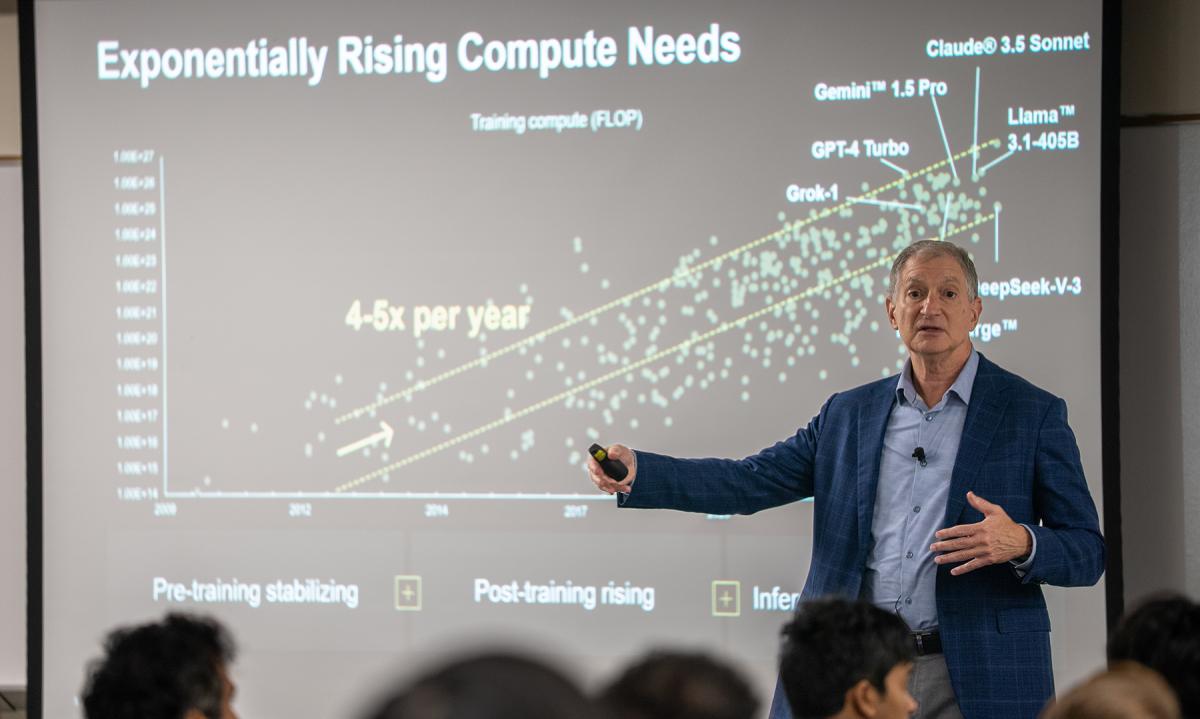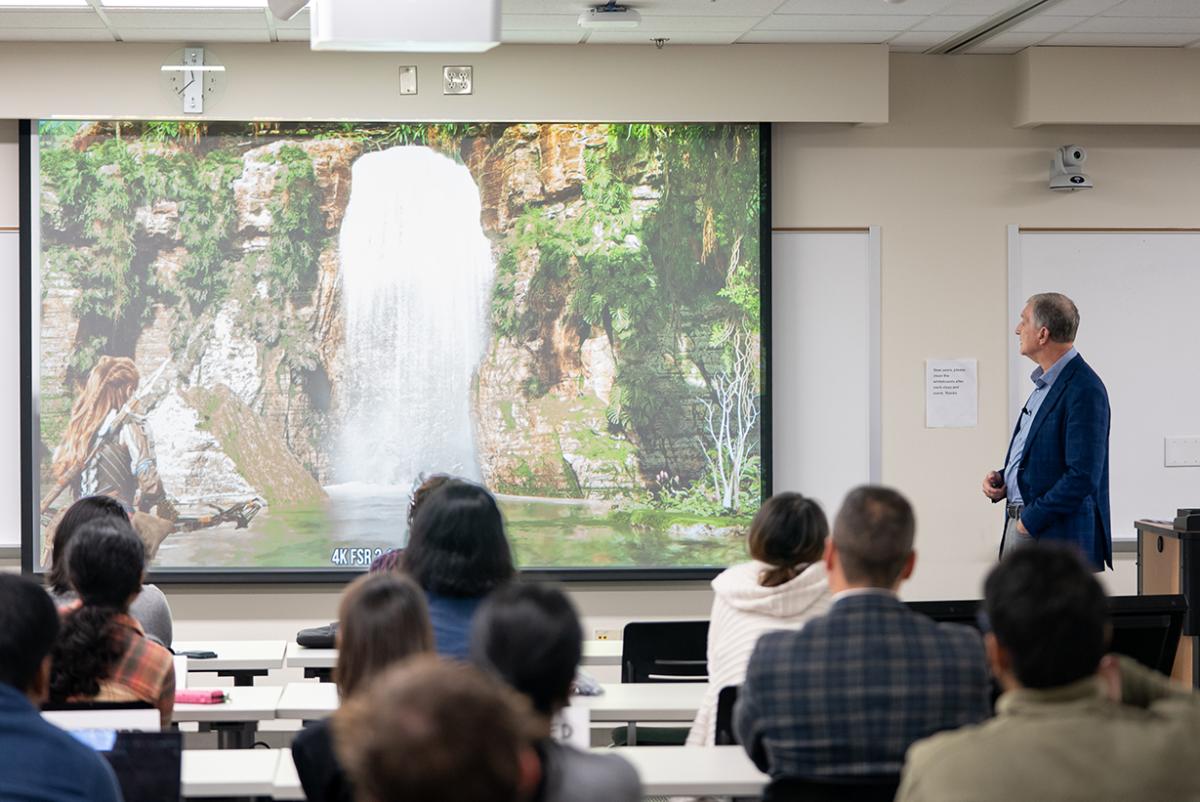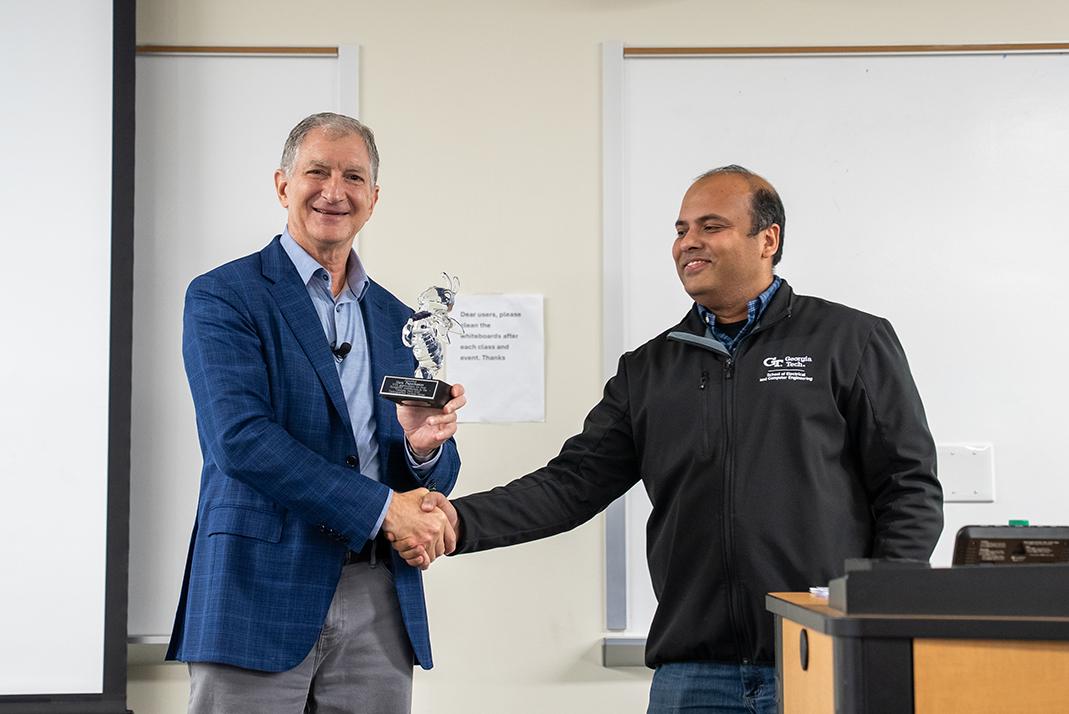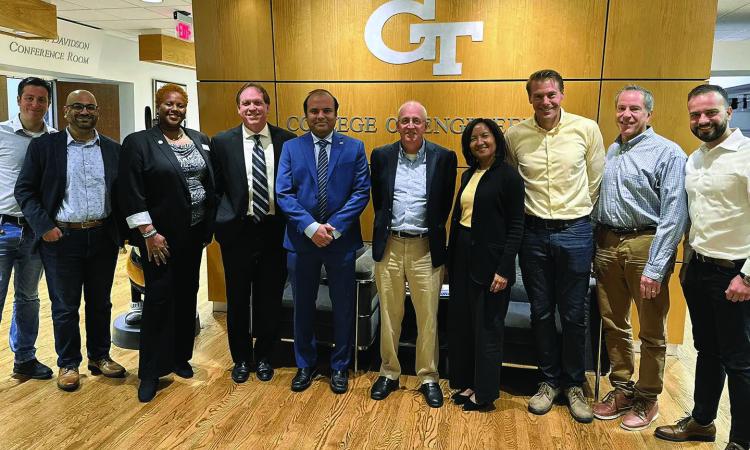One of industry’s top AI and computing experts delivered ECE’s inaugural Carreker Distinguished Lecture, emphasizing that success in the AI era depends on collaboration, integration, and holistic design.

Papermaster during the Georgia Tech School of Electrical and Computer Engineering inaugural Carreker Distinguished Lecture Series.
(text and background only visible when logged in)
The Georgia Tech School of Electrical and Computer Engineering welcomed Mark Papermaster, chief technology officer and executive vice president at Advanced Micro Devices (AMD), for its inaugural Carreker Distinguished Lecture Series on November 13.
Papermaster, a 2025 National Academy of Engineering inductee, spoke to an engaged audience in Klaus 1116 about the transformative impact of artificial intelligence (AI) and the future of high-performance computing.
AMD is a global leader in high-performance computing and semiconductor innovation, making Papermaster’s perspective especially relevant.
He emphasized that the AI inflection point will reshape every industry. Reflecting on more than four decades in technology at IBM, Apple, Cisco, and AMD, Papermaster is exhilarated by the way AI is enabling engineers to become far more capable than previous generations.
“I wish I was starting my education now because it’s such an exciting time,” he said.
Papermaster encouraged up and coming engineers to embrace AI as a tool that amplifies their impact while reminding them that success will continue to require more than technical expertise.
“Engineers who thrive will embrace AI because it will make every technologist multiple times the contributor they could have been without it,” he said. “Today’s engineers are getting help with tasks that used to take hours and now can be completed in minutes. This shift allows engineers to balance technical problem solving with their soft skills: communicating effectively, collaborating with others, and working across disciplines. This balance has never been more important than in the AI era.”
(text and background only visible when logged in)
(text and background only visible when logged in)
A major theme of Papermaster’s keynote was AI for science, which he called a once-in-a-generation opportunity to accelerate breakthroughs from drug discovery to fusion energy. He explained that scaling AI sustainably requires a smarter integration of high-precision scientific computing and AI optimized techniques to speed time to discovery while reducing computation power.
Papermaster also described AMD’s vision for holistic design, a guiding principle across its R&D efforts which aim to yield power and efficiency gains by optimizing at the system level with deep cross-discipline co-development and co-innovation.
Papermaster illustrated holistic design with AMD’s “Helios” rack-scale architecture, co-developed with Meta and the Open Compute Project, which integrates compute, networking, and cooling through open standards. He noted that Helios exemplifies how hardware-software co-optimization delivers order-of-magnitude efficiency gains that are becoming vital as the industry approaches power and bandwidth ceilings.
“You cannot problem-solve just your domain anymore,” he said. “Innovation depends on breaking barriers and working together.”
(text and background only visible when logged in)

Georgia Tech and AMD leadership attending the November 2025 ECE Carreker Distinguished Lecture featuring Mark Papermaster. L-R: Nick Otto (ECE Advisory Board Member), Arijit Raychowdhury (ECE Steve W. Chaddick School Chair), Papermaster, Tim Lieuwen (Georgia Tech Executive Vice President for Research), Shan Pesaru (ECE Advisory Board Chair), Jayashree Rangarajan (AMD Adaptive and Embedded Computing Group), Patricia Allen (ECE Director of Corporate Engagement), and Andrew Schmidt (AMD University Program).

Papermaster discussing smarter integration of high-precision scientific computing and AI optimized techniques to speed time to discovery while reducing computation power.

Raychowdhury delivering a glass Georgia Tech Buzz keepsake to Papermaster, commemorating the lecture.
Beyond the lecture, Papermaster toured Georgia Tech’s Marcus Nanotechnology Building, including its 10,000-square-foot cleanroom. He also visited ECE’s Interdisciplinary Commons, one of the nation’s largest electronic-oriented student makerspaces.
He praised Georgia Tech’s leadership in advanced packaging technologies, calling it “a huge area of innovation which AMD values deeply.”
He noted that Georgia Tech is driving learning and application of technology in ways that align with AMD’s vision.
“I’m so impressed with what [Georgia Tech] is doing and will do in the future,” he said. “At AMD, we look forward to growing our collaboration with Georgia Tech.”
ECE Steve W. Chaddick School Chair Arijit Raychowdhury echoed the sentiment.
“We are grateful to Mark and AMD for sharing this vision and for their continued collaboration with Georgia Tech,” Raychowdhury said. “Together, we are excited to tackle the toughest challenges in computing and shape the future of technology.”
Papermaster closed with a challenge for Georgia Tech students to seize the moment.
“In this AI-first era, the future is engineered, and you are the future,” he said. “Engage, take on the toughest problems. When you look back on your career, there’s nothing better than knowing you helped solve problems and pushed technology forward.”
(text and background only visible when logged in)
Related Content
NVIDIA Chief Scientist Talks Future of AI Hardware at ECE Distinguished Lecture
The visit coincided with the launch of the AI Makerspace, continuing the discussion of collaboration between academia and industry while inspiring ECE students to explore topics at the forefront of field.
(text and background only visible when logged in)
Georgia Tech Is at the Leading Edge of Semiconductor Research
Georgia Tech is playing a significant role in creating the next generation of chips, as the Institute is especially well positioned to innovate in the semiconductor field.
(text and background only visible when logged in)
